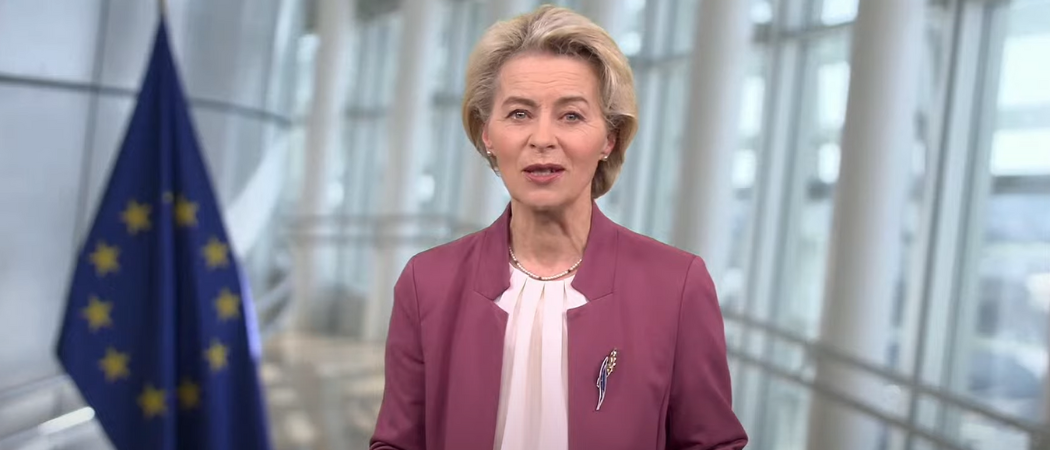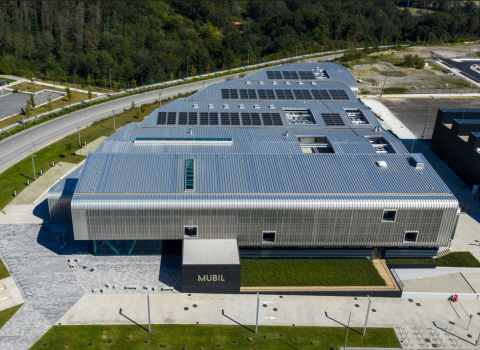Commission President Ursula von der Leyen told European Hydrogen Week the scheme will put in a total of €3B to encourage green production methods. That should be a spur for innovation, but the conference heard of concerns about the direction of the EU’s Clean Hydrogen partnership

European Commission President Ursula von der Leyen speaking during EU Hydrogen Week. Photo: European Union
The European Commission has made a new move to encourage the scale up and deployment of renewable hydrogen, opening the first auction under the European Hydrogen Bank, with €800 million available now through the Innovation Fund to subsidise production, and a further €2.2 billion to come early next year.
Producers will bid for a fixed premium per kilogram of hydrogen produced, to help them cover the additional costs of producing clean hydrogen.
The announcement of the €3 billion subsidy scheme was made at European Hydrogen Week on Monday by Commission President Ursula von der Leyen. The scheme should be a boost for the work of the Clean Hydrogen Joint Undertaking, the public-private partnership set up to scale up development and deployment of renewable hydrogen.
However, in a debate about the partnership on Wednesday, delegates heard it faces an uncertain future as it seeks to define its role in relation to all the other initiatives that have sprung up on the back of the decision to give hydrogen a prominent role in the EU’s climate strategy.
The current partnership is the successor to the Fuel Cells and Hydrogen Joint Undertaking, which launched in 2008, when hydrogen was a niche in the energy sector.
“For the first 10 years we were the [only] ones doing hydrogen in Europe at the EU level,” said Mirela Atanasiu, interim executive director of the JU, during the debate.
In 2020, when the EU adopted its hydrogen strategy it simultaneously launched the Clean Hydrogen Alliance to bring industry, national and local authorities and other stakeholders together to support the large scale deployment of the technology.
“I think the partnership has started to lose its identity,” Atanasiu said. “We now have to redefine ourselves and accept what is our exact role and where the partnership can make a difference.”
The partnership’s budget runs until 2027, but will continue to implement projects until 2031. It is waiting to learn whether its mandate will be renewed.
“I have full faith that our mid-term review is going to go very well and we will still have a lot of support from the Commission for the continuation of the JU,” said Melissa Verykios, chair of the partnership’s governing board.
The hydrogen sector does however require more EU funding, and the partnership must improve how it collaborates with other partnerships and with the Innovation Fund, which promotes highly innovative projects which can reduce emissions, she added.
Bernd Biervert, head of the clean energy transitions unit in the Commission’s directorate general for research, said the partnership has helped to focus projects through a single instrument, but that in the coming years attention will have to turn to scaling up and manufacturing.
“Given the urgency of the planetary crisis we are in, I think we have to be ready in 10 years to have a massive roll-out of technology,” he said.
Exploring new sectors
There are lessons to be learned from the early days of the first joint undertaking, said Jorgo Chatzimarkakis, CEO of Hydrogen Europe, which represents industry in the Clean Hydrogen partnership. The initial focus on the mobility sector was too narrow and was eventually expanded to reflect hydrogen’s wider potential for the energy sector, he explained.
“We’re back at that point again where we need to broaden the scope of hydrogen. The hydrogen strategy from 2020 is focusing very much on green hydrogen,” he said. Green hydrogen is produced by the electrolysis of water, using renewable electricity.
“Now we understand we can do it, but we still won’t have enough hydrogen to serve all the purposes we need,” Chatzimarkakis said.
Novel production processes, including using plastic waste and seaweed, should be studied, he said. These could simultaneously deal with other problems. “Waste is an issue where hydrogen can definitely play a role, not with electrolysis, but with other technologies,” said Chatzimarkakis.
Hydrogen is also an enabler of other technologies, meaning the JU could team up with other industries, Chatzimarkakis said. He offered the example of the maritime sector for the collection of seaweed, which can provide green CO2 for synthetic fuels, which also require hydrogen.
Hydrogen targets
Europe has set a target of producing 10 million tonnes of renewable hydrogen per year in Europe and importing 10 million tonnes by 2030, but high costs of production and a lack of infrastructure are holding the sector back. Currently 95% of hydrogen is produced using fossil fuels.
International cooperation to build a global market for hydrogen is also central to Europe’s strategy and in a video message to the European Hydrogen Week, von der Leyen announced an agreement for the EU to support one of the biggest hydrogen projects in the world, in the Brazilian state of Piaui.
As part of a €2 billion investment in Brazil’s hydrogen value chain through the EU’s Global Gateway strategy, a 10 GW production facility will be built to produce clean hydrogen and ammonia, which will be shipped to Croatia in order to serve south-east Europe.
The EU has also signed partnerships with countries in Africa and Latin America, and von der Leyen said new initiatives would be discussed with Kazakhstan, Australia and Oman.





 A unique international forum for public research organisations and companies to connect their external engagement with strategic interests around their R&D system.
A unique international forum for public research organisations and companies to connect their external engagement with strategic interests around their R&D system.